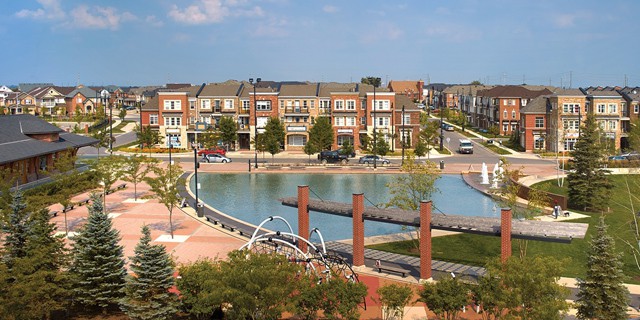Should Brampton City Council Wards Have Names?
Published April 14, 2017 at 4:25 am

The city of Brampton currently has 10 wards, with two being represented by one city councillor and one city/regional councillor. So in Wards 1 and 5, you have one councillor sitting on Brampton city council and another sitting on city and regional council.
The city of Brampton currently has 10 wards, with two being represented by one city councillor and one city/regional councillor. So in Wards 1 and 5, you have one councillor sitting on Brampton city council and another sitting on city and regional council.
It’s a rather convoluted system that has been recently well documented, prompting vigorous debate in Peel Regional Council about the number of seats Brampton should have at the region, or how to seat all their councillors at the region. But I’ve got another question pertaining to Brampton’s city wards: why are they numbered instead of given a proper name?
I think if you ask the average person on the street in Brampton, they wouldn’t know which ward they live in, let alone the corresponding number. And let’s remember, their councillor represents two wards, so technically residents would have to figure out which of the two wards they reside in. Isn’t that just a bit confusing?
The last federal and provincial riding redistribution gave Brampton five Members of Parliament representing five ridings, with names easy enough to remember (Brampton Centre, Brampton East, Brampton North, Brampton South, and Brampton West). So why can’t we find names of municipal wards based on the various areas in Brampton where people reside?
There are many example of other cities that besides using a number, also use names to identify their municipal wards.
Hamilton, Ontario
The City of Hamilton has 15 city councillors whose wards, besides being given a number, have a second name based on communities in the old city of Hamilton or the former towns that were amalgamated into the current city in 2000. Ward 4 is known as East Hamilton, Ward 8 is West Mountain, Ward 12 is known as Ancaster, and Ward 14 is known as Flamborough.
Kingston, Ontario
The city of Kingston has electoral areas for their councillors that have names based on community areas similar to the previous two examples, although one distinct difference is that they’re not called wards, but districts.
Ottawa, Ontario
Ottawa has 23 wards whose names correspond with certain areas within each boundary, geographical location, historical or cultural linkages. Capital Ward is named as such because of Ottawa’s status as Canada’s capital city, Bay Ward is called that because of at least three neighbourhoods along the western side of the Ottawa river with the name ‘bay’ in them, and there are two wards named ‘Kanata North’ and ‘Kanata South’ because they happen to comprise the former city of Kanata.
Toronto, Ontario
The council wards in Canada’s largest city were based on the federal Parliament riding boundaries from 1997-2004, dividing each riding in two. Hence, the wards are based on the names of the federal ridings some 20 years ago. Toronto has just concluded a ward boundary review where additional wards were added in the downtown area to accommodate the rapid growth in that area, but they appear to be keeping the old names.
But Brampton has a unique circumstance apart from surrounding municipalities in that it doesn’t have official neighbourhood names, but rather what they term ‘secondary plans.’ As a Brampton spokesperson recently told inBrampton.com, “if you think of the Official Plan as the road map for all of Brampton, secondary plans are the detailed plans for specific areas and provide information on things like roads, parks, land use and community design.”
Here is the current map of the current secondary plans of Brampton. And below is the current ward map of Brampton:
Let’s for simplicity sake give names to each individually numbered ward instead of the pairings they’re currently in (Wards 1-5, Wards 3-4, Wards 2-6, Wards 7-8, and Wards 9-10) These are just my own suggestions based on the current ward boundaries and matching them based on the current set of secondary plans:
-
Ward 1: Downtown Brampton
-
Ward 2: Snelgrove-Heart Lake
-
Ward 3: Brampton Industrial
-
Ward 4: Fletcher’s Creek
-
Ward 5: Northwood Park-Credit Valley
-
Ward 6: Huttonville-Mount Pleasant
-
Ward 7: The Gateways
-
Ward 8: Bramalea-Gore
-
Ward 9: Sandringham-Wellington
-
Ward 10: Brampton East
Some of these I was kind of fudging it; Ward 3 as “Brampton Industrial” was because a number of secondary plans were named “industrial” or designated industrial land. I aptly named Ward 7 “The Gateways” because of three secondary plans with the word ‘gate’ in their names. And there were four secondary plans in Ward 10 where it was easier to use a common name like ‘Brampton East’ that sounds more familiar for those residents in that area.
Also, this arrangement would work best if Brampton ever decided to follow Mississauga’s lead and agreed to go it alone as a single tier municipality. They could do away with this complicated system of having two councillors representing two wards as one and just have one mayor, 10 councillors and one ward each. It would make things much simpler.
What do you think, Brampton? Would you rather have city council wards that had actual names or have them go by numbers?
UPDATE: I would like to thank some informed readers of pointing out that I may have omitted some very well known, historic neighbourhoods in Brampton that could provide alternative names to certain wards that were outlined. So perhaps Ward 3 could be known as the “Peel Village” ward rather than the stoically sounding “Brampton Industrial” that I proposed earlier. Likewise, Ward 9 could better be known as “Springdale” rather than the obscure secondary plan name of “Sandringham-Wellington” which one reader mentioned had been rather obsolete since the early 1990s.
In any case, it’s great to hear some Brampton citizens providing some great feedback!
Follow me on Twitter at @thekantastic
INsauga's Editorial Standards and Policies